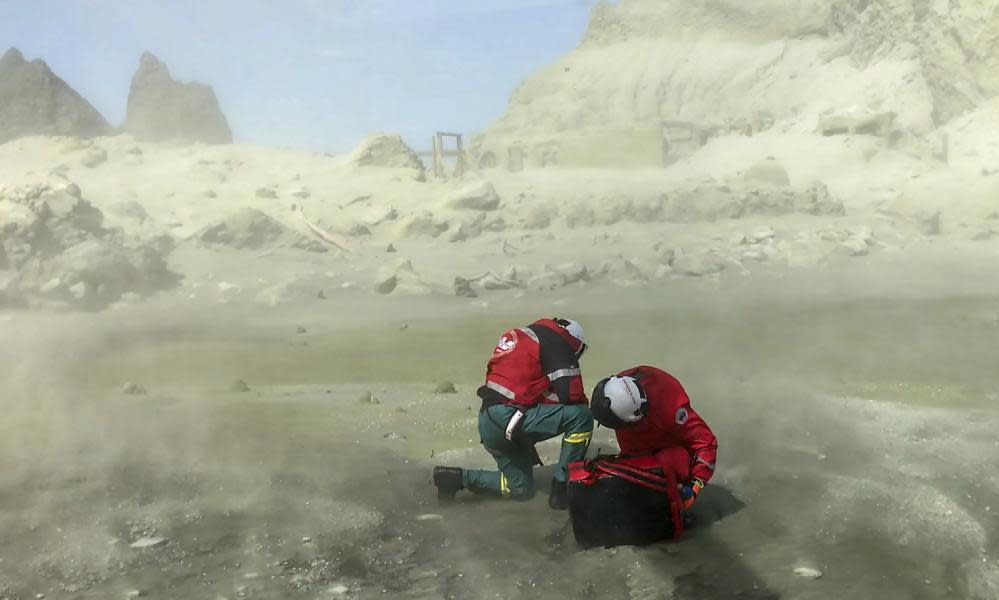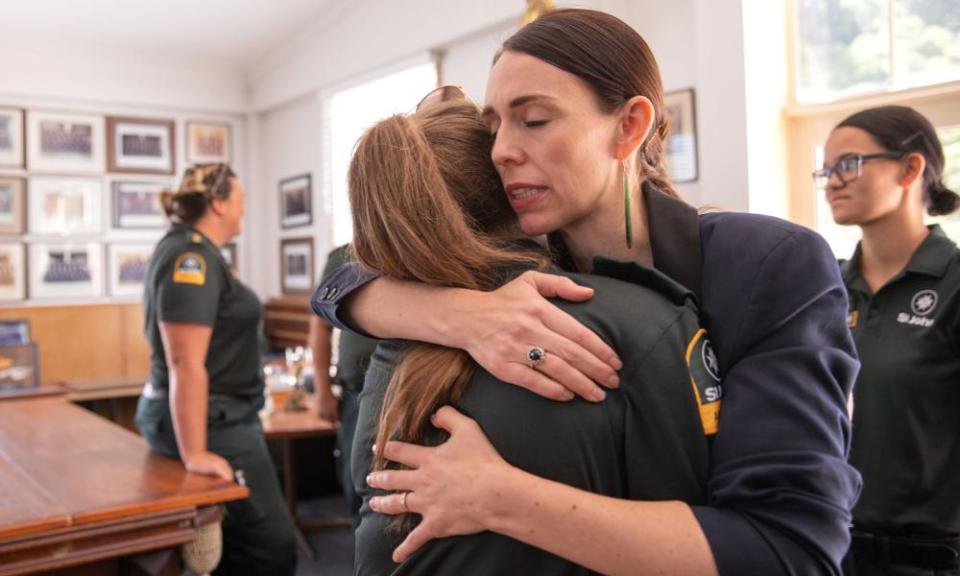White Island volcano victims cannot bring civil lawsuits for negligence

In New Zealand, where bodies still lie on a volcano after Monday’s eruption and survivors fill hospital burns units across the country to capacity, questions are mounting about who exactly was responsible for the safety of tourists on Whakaari or White Island, and, if failings are found, who will be held accountable.
Questions are also being asked about the wisdom of allowing tourists on to the island while it was assigned a volcanic alert level of two out of five, signalling volcanic unrest – a practice that has happened for years.
But one thing that is already clear is that those hurt in the eruption will be prevented from bringing civil lawsuits in New Zealand against the tour companies who took them to the island, or anyone else.
Related: New Zealand volcano: police plan body retrieval on Friday despite eruption risk
New Zealand’s accident compensation scheme, run by the government, covers the cost of all treatment for injuries sustained in New Zealand, including for foreigners. Its coverage, which the injured cannot opt out of, bars them from suing for negligence.
Bill Hodge, a retired law professor at the University of Auckland, says the system of absolving operators from the threat of lawsuits had given rise to a “cutting-edge” adventure tourism industry in New Zealand.
Simon Milne, a tourism professor at Auckland University of Technology agreed: “There’s no question about that.”
“Our accident compensation system has basically underwritten and enabled the development of adventure experiences and products that would have difficulty in being established elsewhere around the world.”
However Hodge said it was possible that named individuals from a tour company could be prosecuted under New Zealand’s workplace health and safety laws if failings were found. He said such a prosecution was more likely than a criminal manslaughter case.
The law, introduced in 2015 after a 2010 mine explosion that killed 29 workers on New Zealand’s South Island, threatens penalties of up to five years in prison and fines of $NZ3m (US$2m), for anyone failing to keep people, including visitors, safe in a place of work, although no one has been sentenced to a jail term under it.
While tourist activities on active volcanoes are a draw in New Zealand and elsewhere in the world, analysts said that in some ways, White Island’s situation seems unique.
As well as its status as an active volcano that is easy to reach and highly accessible right up to its crater, Whakaari – which is uninhabited – is privately owned by a single family and in an unusual regulatory position where its day-to-day affairs are administered by a government agency, rather than by the local council.

Its tourism operations have for years been guided, but not dictated, by a scientific alert level that some commentators say must now be reviewed.
“We monitor the volcano, we set the alert level and the accompanying bulletin is to inform everybody,” said Bradley Scott, a volcanologist for the science agency GNS, who has been visiting Whakaari for 40 years.
There’ll be a lot of soul-searching around the parameters by which these groups operate
Shane Cronin, volcanologist
How the information is acted upon at each volcanic location in New Zealand depends on “who the agencies involved are and what their response plans are,” he said. Similar alerts systems, considered international best practice, are used in as many as 20 countries worldwide, but in some nations, increased levels of alert generate action, such as evacuations.
Tours had run to the island during conditions such as on Monday for years. Scott himself planned to visit the island this week, and a bulletin issued by GNS on 3 December said the current activity “does not pose a direct hazard to visitors.”
How the information provided by the science agency is enacted varies from place to place, and some analysts say the system should be more consistent.
“There’ll be a lot of soul-searching around the parameters by which these groups operate,” said Shane Cronin, a volcanologist at the University of Auckland. “And I think there should be quite a bit of soul-searching about how the alert level systems are understood and used.”
Two other active volcanoes on New Zealand’s North Island are popular with tourists. Several hours drive south, and inland, from Whakaari stands one of them, Mt Ruapehu, a popular ski destination. It last erupted in 2007.
That district’s mayor, Don Cameron, told the news outlet Stuff that he would review the mountain’s safety systems. Ruapehu is owned by New Zealand’s Department of Conservation, which decides whether skiers should be allowed on its upper slopes.
It is not clear what safety decisions were made about tourists accessing Whakaari this week by the family who privately owns the island and issues leases to tour operators, or solely by the operators themselves. None of the four tour companies that run trips to the island, nor the Buttle family which owns the island, would answer questions this week.
Scott from GNS said every volcano was different: “On Ruapehu, the top of the ski field is four kilometres from the crater,” he said. “Where the people get off the boat at White Island is 700 metres from the crater.”
Asked whether the management regime of the island reflected the level of potential risk, Scott said: “I don’t think that’s probably very well understood by everybody.”
He said it was too early in the recovery and investigation process to comment further.
While there have been fraught debates about tourist access to other volcanoes overseas, including Japan’s Mt Ontake, where 63 people died in 2014, Mt Yasur, in Vanuatu, where there have been several deaths in recent years, and Kilauea in Hawaii, tourism analysts in New Zealand said the risks of Whakaari, or White Island, would need to be examined more closely.
“Visitors are more removed from that active crater area in those other places, which means that there’s more opportunity to escape from that active volcano area,” said Simon Milne, a tourism professor at Auckland University of Technology. “That wasn’t the case in White Island.”
White Island is also outside the jurisdiction of its district and regional councils because of its distance from shore of 48 kilometres, so it was not included in local civil defence planning until 2017, a former mayor of the nearby city of Tauranga told the Guardian.
“There was no formal structure for who would do what,” in the event of a disaster, said Greg Brownless, who in 2017 was the chair of an emergency management group for Bay of Plenty, where Whakaari is situated.
He said an agreement made between his group and the civil defence minister two years ago ensured that local personnel would take the lead in the event of an eruption of White Island. But he said they were responsible for the aftermath rather than advance warnings.
Because it is so far offshore, New Zealand’s department of internal affairs is responsible for the day-to-day administration of the island, rather than the local council, but Kenneth Palmer, a law professor at the University of Auckland suggested the agency would not have taken a hands-on role.
The department said in an emailed statement that its “functions are limited given the island is uninhabited and undeveloped land under private ownership.” There was no suggestion that the agency took on a safety mandate for tourist activities.
Ardern, the prime minister, told New Zealand’s parliament on Tuesday that there were questions that “must be asked” about the eruption, and those questions “must be answered”. She did not say what form such an inquiry would take.
A royal commission or judicial inquiry will likely not be an option, Tracey Martin, the internal affairs minister, told reporters. New Zealand would be “very hard-pressed” to handle a third such inquiry simultaneously, she said. One is already being carried out into the Christchurch shootings in March, and another into the abuse of children in state care.
New Zealand’s police said on Tuesday evening that they had initiated a criminal investigation into the disaster; hours later they reversed the statement, saying it was an investigation on behalf of the coroner.
Police say they will attempt to recover the bodies from the island on Friday.

 Yahoo News
Yahoo News 
